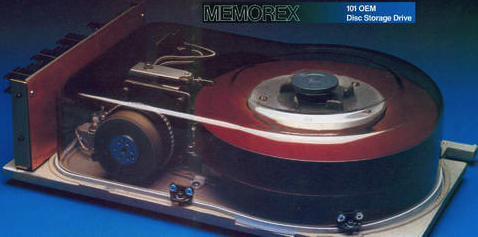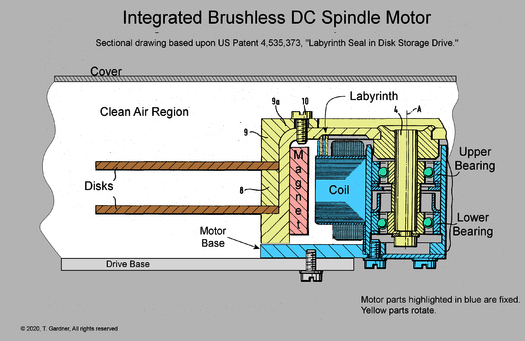History (1979): IMI 7700, First Brushless DC Spindle Motor for HDDs
By International Memories, Inc.
This is a Press Release edited by StorageNewsletter.com on April 6, 2020 at 2:21 pmIMI 7700 Series
1st brushless dc spindle motor
![]() A prototype of this page was completed on November 12, 2007 and it remained essentially unchanged until a major update was posted on April 2, 2020 by Tom Gardner, current treasurer and webmaster at IEEE Silicon Valley History Committee, president, System Surety Group, volunteer, Computer History Museum, and observer, NCITS/ANSI Standards Committees. He was also in the past VP and GM, SyQuest Technology (1991-1996), and VP and GM, Shugart Corporation (1982-1985).
A prototype of this page was completed on November 12, 2007 and it remained essentially unchanged until a major update was posted on April 2, 2020 by Tom Gardner, current treasurer and webmaster at IEEE Silicon Valley History Committee, president, System Surety Group, volunteer, Computer History Museum, and observer, NCITS/ANSI Standards Committees. He was also in the past VP and GM, SyQuest Technology (1991-1996), and VP and GM, Shugart Corporation (1982-1985).
Why it’s important:
The ever shrinking and improving hard disk drive has been enabled by the transition to a motor/spindle based upon brushless dc motor technology first implemented in production hard disk drives by the 1979 International Memories, Inc.’s (IMI, Cupertino, CA) 7710.
Papst-Motoren the early technical leader and significant supplier was by 1989 replaced in the market by Nidec.
Discussion
Beginning with the first HDD in 1957, the mechanism for turning the disks of the drive has evolved over more than 50 years from large ac motors connected to a separate spindle to brushless dc motors fully integrated with the spindle. Similarly contamination control evolved from external blowers with large air filters to sealed units with small breather and internal filters. Ultimately the spindle ball bearings were replaced by fluid dynamic bearings. Collectively these improvements supported smaller size, lower cost, higher reliability, less noise and higher density.
The first HDD, the IBM RAMAC 350 initially shipped with a large ac motor directly mounted to the spindle but soon after shipment it switched to a gear drive connecting the motor to the spindle. Airborne environmental contaminants were not a substantial problem since its hydrostatic heads floated on filtered clean air supplied by a compressor.
However a spinning disk creates a low pressure region at its center that without amelioration would suck contamination into the head disk region. The first HDD to use self-flying heads, the Bryant 4000 enclosed the heads and disks in a clean region using a blower to feed by room air thru a one micron particle filter thereby preventing contamination through the spindle. A large machine the spindle was driven two belts connected to an ac motor. By the 1970s most disk drives were constructed in this manner.
As illustrated by the figure to below (for a disk pack drive) an ac motor is connected to the spindle with a belt pulley system. As in the Bryant drive, contamination by leakage through the spindle bearing was eliminated by pressurizing the disk area with clean air so as to cause some air to flow out through the spindle bearings. Flow needs to be outward but minimal so as to avoid drying out the bearing’s lubricant. Means of minimizing flow thru bearings include bearing shields and other mechanical barriers such as Nilos rings and ferrofluidic seals.

AC motors are reliable and provide the large torque required for the 14-inch and larger disks used in most early HDDs; however, HDDs of that era required one rotational speed and since an ac motor’s rotational speed is determined by line frequency this required mechanical designs specific to a country – typically a pulley change. Speed variation due to pulley wear was also a problem.
Librascope in the 1960s produced a line of HDDs with smaller disks using ac motors directly connected to the spindle thus eliminating parts.
The early 1970s saw the first use of brushed dc motors in HDDs. DC motors have the advantage that speed can be precisely controlled independent of ac line frequency. The 1970 Diablo model 30 cartridge disk drive directly connected the motor to the spindle. The 1976 CDC model 9414 integrated a brushed dc motor into the spindle. Brushes wear out and generate particles, neither of which is desirable in an HDD. The 9414 used a labyrinth seal between the rotating cup of the spindle and the fixed parts of the motor to keep particles, including brush particles out of the clean head and disk region.
The late 1970s saw the beginning of the transition to smaller disk drives using disks less than the then standard 14-inch diameter. Volume and cost precluded the use of blowers in the smaller HDDs leading to the use of an internal filter to capture particles and a breather filter to control flow into and out of the clean region as air pressure changed. Simultaneously these constraints led to the introduction of spindle motors using brushless dc motor technology initially by companies such as IMI and Memorex.
IMI 7710 Disk Drive (1979)
It was the first production HDD known to use a brushless dc motor directly. As shown above, the spindle (yellow) is directly connected to the shaft of a brushless dc motor; the fixed parts of the motor (blue) then attach to the base of the HDD. This is an inside-out motor in that the housing rotates along with the shaft. It was also one of the few disk drives with a plastic base casting.


Memorex 101 Disk Drive (1980)
It was the first production HDD known to use an integrated spindle motor with brushless dc motor technology. As shown above, the hub of the motor (yellow) rotates and carries the disks on one side and the magnets on the other side. It incorporated a labyrinth seal to minimized contamination thru the spindle bearings.


In the 1970s and 1980s Papst-Motoren KG (St. Goergen Germany), was a leading motor manufacturer with a technical sales representative calling on all the US disk drive manufacturers.
The IMI motor patent used for the illustration on the left above was jointly assigned to Papst and IMI. Papst’s US patent 4,535,373, used for the illustration on the right above claims the use of labyrinth seal in HDDs interactions even though the invention appears to have been anticipated in both the Memorex 101 and the CDC 9414. These are 2 examples of the more than 40 patents on HDD’s and their motors that were issued to Papst as a result of its close design relationship with the HDD manufacturers. Papst sued most HDD manufacturers, some more than once, and collected more than $100 million in settlement royalties. A supplier to many HDD manufacturers during the 1980s, it lost market share to Japanese manufacturers and essentially exited the manufacturing of spindle motors in the 1990s. It continued as Papst Licensing GmbH suing HDD manufacturers into the late 1990s.
Nidec Corporation (Kyoto Japan) was founded in 1973 as an ac motor company and in 1984 started production of spindle motors for 3.5-inch HDDs. It is known for active use of mergers and acquisitions as a strategy to grow its businesses. In March 1989, Nidec acquired Shinano Tokki Co, Ltd, a manufacturer of spindle motors for HDDs gaining the largest share of the independent spindle motor market in the world. It continued to dominate the global spindle motor market into this century with a 2003 market share of over 65%.
In 1994 Maxtor began using fluid dynamic bearings in place of conventional ball bearings for their superior precision and performance.It abandoned this technology but then the industry led by Seagate reintroduced it so that by 2004 such bearings dominated production.
Nidec while not initially a leader in this technology acquired production facilities and knowhow from Seagate in 2000 and as of 2019 was supplying 80-85% of all HDD spindle motors used globally.
Provenance note:
In 2007 the Computer History Museum’s Storage SIG voted the IMI 7710 as a significant product in HDD history for its first usage of a brushless dc motor in a production.













 Subscribe to our free daily newsletter
Subscribe to our free daily newsletter

